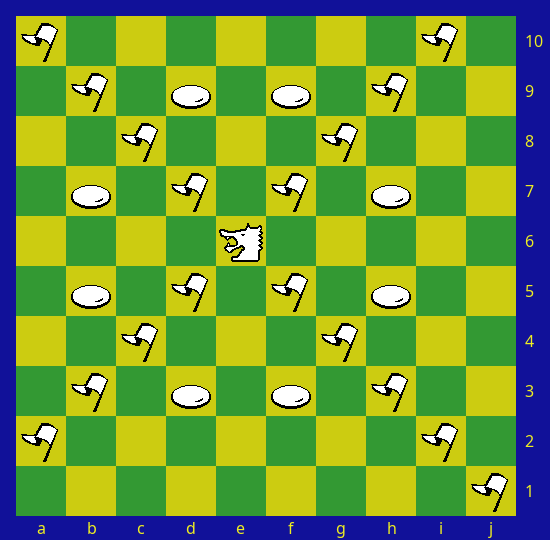[ List Earliest Comments Only For Pages | Games | Rated Pages | Rated Games | Subjects of Discussion ]
Comments/Ratings for a Single Item
Hi Joe
My 'Carrousel Chess' variant (preset pending final review) uses reflecting bishops (and squirrels) instead of bishops (and knights) in what is otherwise straight Circular Chess. On such a round board, when it's empty, reflecting bishops are in effect "Missiles" of full strength, since on an empty board they can bounce their way off the edges around to every cell of their colour on the board. I was afraid that Carrousel Chess might be unplayable, or the moves of the reflecting bishops too hard to visualize, as the game unfolds, but perhaps time will tell.
2 comments displayed
Permalink to the exact comments currently displayed.
Once again I find myself with a game that needs to be posted, and this one isn't even my style. Most commenters and players here seem to like very powerful long-range pieces on boards no bigger than 10x10. In particular over the years, Carlos Cetina and Jeremy Good have pushed me in that direction more than anyone else. A couple days ago, I was looking over Kevin Pacey's movement diagram for the Flying Dragon in Butterfly Chess:
If you push this idea to the limit, you get a white "bishop" that hits every single white square every single turn, and if you make it unblockable, you have a white missile. You can't make it completely unblockable, because on a FIDE board, 1. f1-e8 checkmate! And that board is still a bit small. So use Grand Chess as the vehicle. All the pieces keep their moves, though they may not start on the same squares. All the pieces get an extra power.
Clearly you have to restrict the missiles. Let the rooks be anti-missile batteries. No missile may land within 2 squares of a friendly rook. Add this power to the queen, chancellor, and archbishop, also.
Restricting missiles further, bishops may only be used as missiles from their original squares. They may move off and back on again, and still fire.
A bishop fired as a missile is destroyed on impact, and a new bishop/missile is placed on the original bishop's square. While each side may only ever have 1 bishop of each color on the board at any time, there is no limit to the number of missiles that can be fired and replaced.
Now missiles are too powerful, so they are restricted again. A missile must be fired by one of the 3 major pieces, Q, A, or C, which must be directly behind the bishop to fire and replace it.
Now the initial set-up is shifted slightly by moving 2 of the major pieces directly behind the 2 bishops, sliding the kings 1 square right in the above diagram, and placing the 3rd major piece on the vacated king's square.
Now we mess with the knights. In addition to their standard move, they gain the cannon attack. They may move any number of squares orthogonally, jump over a piece, and capture the next piece along that file or rank.
This is as far as I've gotten. The defense for 1. Nb2-a4 is to drop a missile on the knight. Note missiles can only hit pawns, knights, bishops, and kings, and none of the major pieces, the ones that can force mate with the king, at this point. Comments? Suggestions?